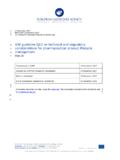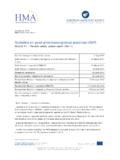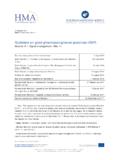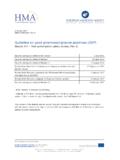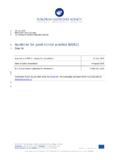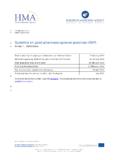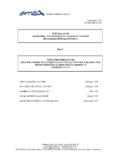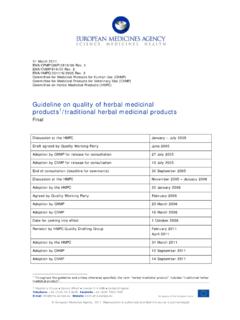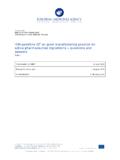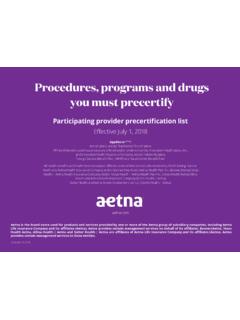Transcription of ANNEX I SUMMARY OF PRODUCT CHARACTERISTICS
1 1 ANNEX ISUMMARY OF PRODUCT OF THE MEDICINAL PRODUCTSTELARA 130mg concentrate for solution for AND QUANTITATIVE COMPOSITIONEach vial contains 130mg ustekinumab in 26mL (5 mg/mL). ustekinumab is a fully human IgG1 monoclonal antibody to interleukin(IL)-12/23 produced in a murine myeloma cell line using recombinant DNA the full list of excipients, see FORMC oncentrate for solution for solution is clear, colourless to light indicationsCrohn s DiseaseSTELARA is indicated for the treatment of adult patients with moderately to severely active Crohn s disease who have had an inadequate response with, lost response to, or were intolerant to either conventional therapy or a TNF antagonist or have medical contraindications to such colitisSTELARA is indicated for the treatment of adult patients with moderately to severely active ulcerative colitis who have had an inadequate response with, lost response to.
2 Or were intolerant to either conventional therapy or a biologic or have medical contraindications to such therapies(see ). and method of administrationSTELARA concentrate for solution for infusion is intended for use under the guidance and supervision of physicians experienced in the diagnosis and treatment of Crohn's diseaseor ulcerative colitis. stelara concentrate for solution for infusion should only be used for the intravenous induction s Diseaseand Ulcerative ColitisSTELARA treatmentis to be initiated with a singleintravenous dosebased on body weight. The infusion solution is to be composed of the number of vials of stelara 130mg as specified in Table1 (see for preparation).3 Table1 Initial intravenousdosing of STELARABody weight of patient at the time of dosingRecommendeddoseaNumber of 130 mg stelara Vials 55 kg260 mg2> 55 kg to 85 kg390 mg3> 85 kg520 mg4aApproximately 6mg/kgThe first subcutaneous dose should be givenat week8 following the intravenousdose.
3 For the posology of the subsequent subcutaneous dosing regimen, see of the stelara solution for injection(vial)and solution for injection in pre-filled ( 65 years)No dose adjustment is needed for elderly patients (see ).Renal and hepatic impairmentSTELARA has not been studied in these patient populations. No dose recommendations can be populationThe safety and efficacy of stelara for the treatment of Crohn s diseaseor ulcerative colitisin children less than 18years have not yet been established. No data are of administrationSTELARA 130mg is for intravenous use only. It should be administered over at least instructions on dilution of the medicinal PRODUCT before administration, see to the active substance or to any of the excipients listed in important, active infection ( active tuberculosis; see ).
4 Warnings and precautions for useTraceabilityIn order to improve the traceability of biological medicinal products, the tradename and the batch number of the administered PRODUCT should be clearly may have the potential to increase the risk of infections and reactivate latent infections. In clinical studies, serious bacterial, fungal, and viral infections have been observed in patients receiving stelara (see ).Caution shouldbe exercised when considering the use of stelara in patients with a chronic infection or a history of recurrent infection(see ).Prior to initiating treatment with stelara , patientsshould be evaluated for tuberculosis infection. stelara mustnot be given to patients with active tuberculosis (see ).
5 Treatment of latent tuberculosis infection should be initiated prior to administering stelara . Anti-tuberculosis therapy should also be considered prior to initiation of stelara in patients with a history of latent or active tuberculosis in whom an adequate course of treatment cannot be confirmed. Patients receiving stelara should be monitored closely for signs and symptoms of active tuberculosis during and after should be instructed to seek medical advice if signs or symptoms suggestive of an infection occur. If a patient develops a serious infection, the patient should be closely monitored and stelara should not be administered until the infection like ustekinumab have the potential to increase the risk of malignancy.
6 Some patients who received stelara in clinical studies developed cutaneous and non-cutaneous malignancies (see ).No studies have been conducted that include patients with a history of malignancy or that continue treatment in patients who develop malignancy while receiving stelara . Thus, caution should be exercised when considering the use of stelara in these patients, in particular those greater than 60years of age, patients with a medical history of prolonged immunosuppressant therapy or those with a history of PUVA treatment, should be monitored for the appearance of non-melanoma skin cancer (see ).Systemic and respiratory hypersensitivity reactionsSystemicSerious hypersensitivity reactions have been reported in the postmarketing setting, in some cases several days after treatment.
7 Anaphylaxis and angioedema have occurred. If an anaphylactic or other serious hypersensitivity reaction occurs, appropriate therapy should be instituted and administration of stelara should be discontinued (see ).RespiratoryCases of allergic alveolitis, eosinophilic pneumonia, and non-infectious organising pneumoniahave been reported during post-approval use of ustekinumab . Clinical presentations included cough, dyspnoea, and interstitial infiltrates following one to three doses. Serious outcomes have included respiratory failure and prolonged hospitalisation. Improvement has been reported after discontinuation of ustekinumab and also, in some cases, administration of corticosteroids. If infection has been excluded and diagnosis is confirmed, discontinue ustekinumab and institute appropriate treatment(see ).
8 VaccinationsIt is recommended that live viral or live bacterial vaccines (such as Bacillus of Calmette and Gu rin (BCG)) should not be given concurrently with stelara . Specific studies have not been conducted in patients who had recently received live viral or live bacterial vaccines. No data are available on the secondary transmission of infection by live vaccines in patients receiving stelara . Before live viral or live bacterial vaccination, treatment with stelara should be withheld for at least 15weeks after the last dose and can be resumed at least 2weeks after vaccination. Prescribers should consult the SUMMARY of PRODUCT CHARACTERISTICS for the specific vaccine for additional information and guidance on concomitant use of immunosuppressive agents receiving stelara may receive concurrent inactivated or non-live term treatment with stelara does not suppress the humoral immune response to pneumococcal polysaccharide or tetanus vaccines (see ).
9 Concomitant immunosuppressive therapyIn psoriasis studies, the safety and efficacy of stelara in combination with immunosuppressants, including biologics, or phototherapy have not been evaluated. In psoriatic arthritis studies, concomitant MTX use did not appear to influence the safety or efficacy of stelara . In Crohn s diseaseand ulcerative colitisstudies, concomitant use of immunosuppressants or corticosteroids did not appear to influence the safety or efficacy of stelara . Caution should be exercised when considering concomitant use of other immunosuppressants and stelara or when transitioning from other immunosuppressive biologics (see ).ImmunotherapySTELARA has not been evaluated in patients who have undergone allergy immunotherapy.
10 It is not known whether stelara may affect allergy skin conditionsIn patients with psoriasis, exfoliative dermatitis has been reported following ustekinumab treatment (see ). Patients with plaque psoriasis may develop erythrodermic psoriasis, with symptoms that may be clinically indistinguishable from exfoliative dermatitis, as part of the natural course of their disease. As part of the monitoring of the patient s psoriasis, physicians should be alert for symptoms of erythrodermic psoriasis or exfoliative dermatitis. If these symptoms occur, appropriate therapy should be instituted. stelara should be discontinued if a drug reaction is populationsElderly ( 65 years)No overall differences in efficacy or safety in patients age65 and older who received stelara were observed compared to younger patientsin clinical studies in approved indications, however the number of patients aged65 and older is not sufficient to determine whether they respond differently from younger patients.
